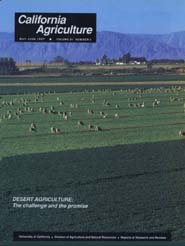All Issues

Desert Agriculture: The challenge and the promise
Cover:
Warm winter weather enables year-round agricultural production in the Low Desert. One of the largest concentrations of sheep in the United States gathers in the Coachella, Imperial and Palo Verde valleys each winter - close to 300,000 head. From November through March, lambs are brought from the mountain states to graze. Photo by Gerald Holmes
May-June 1997
Volume 51, Number 3
Volume 51, Number 3





